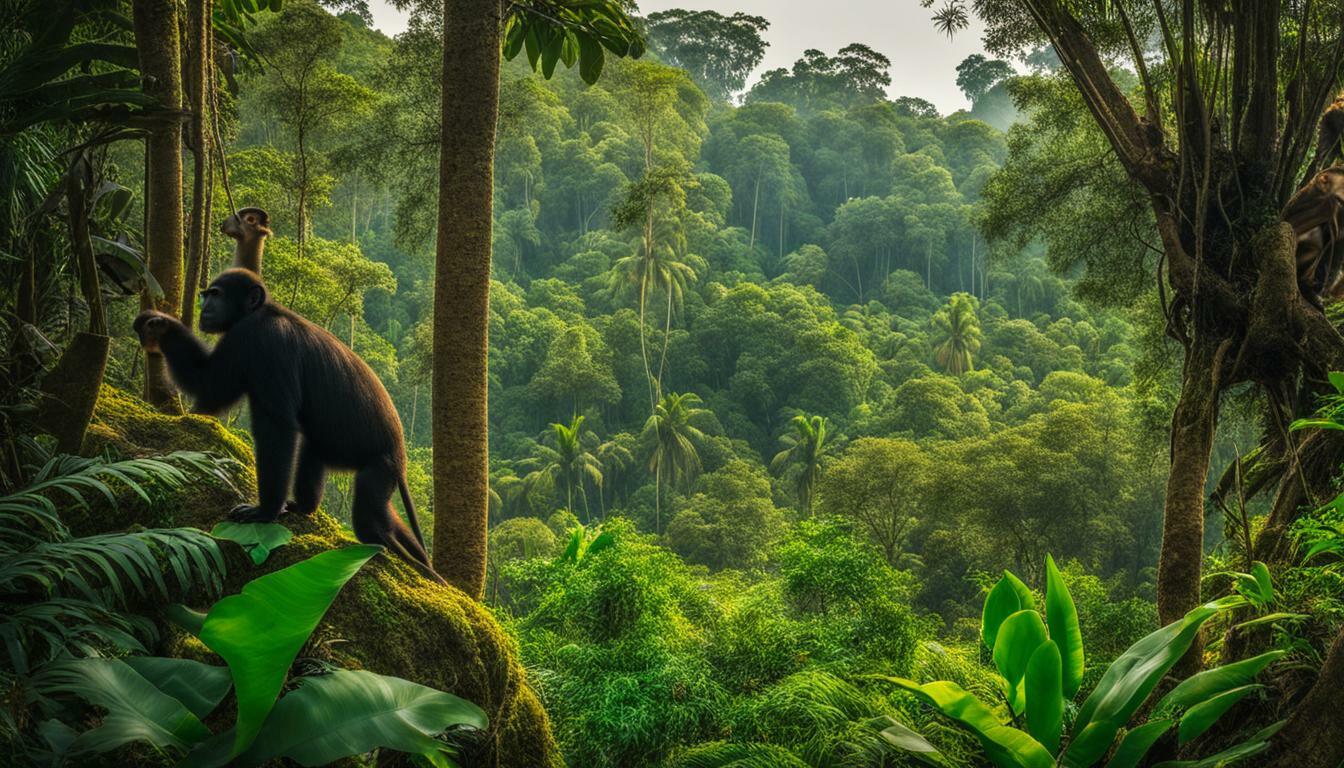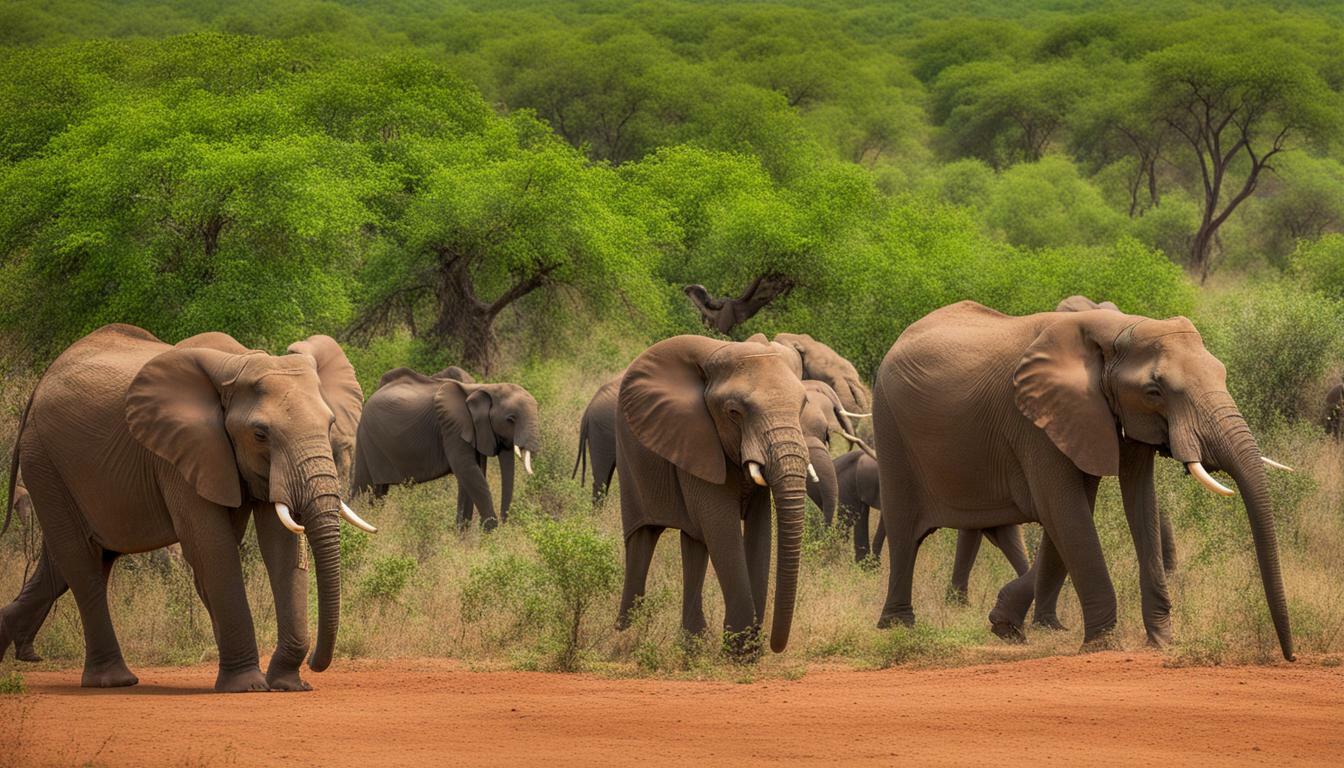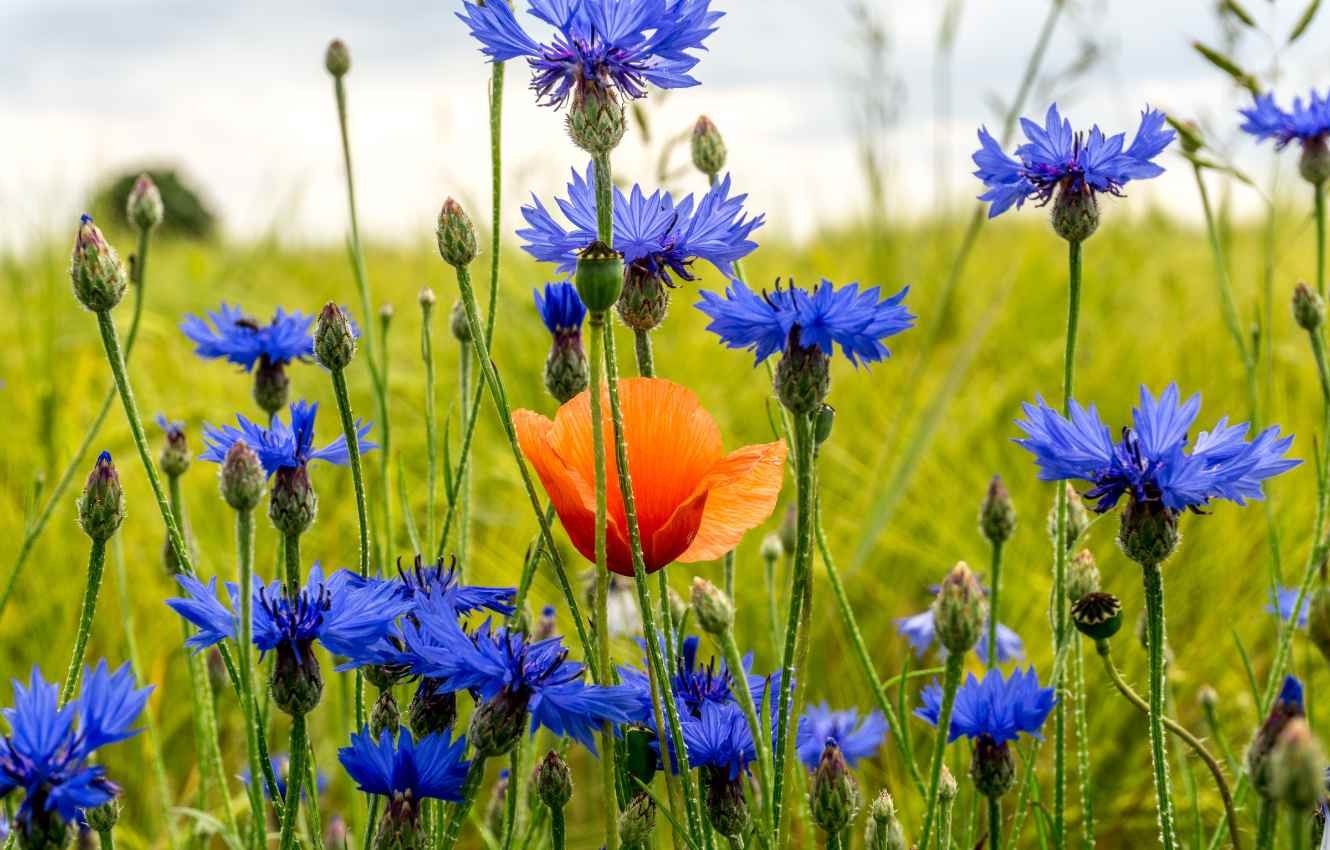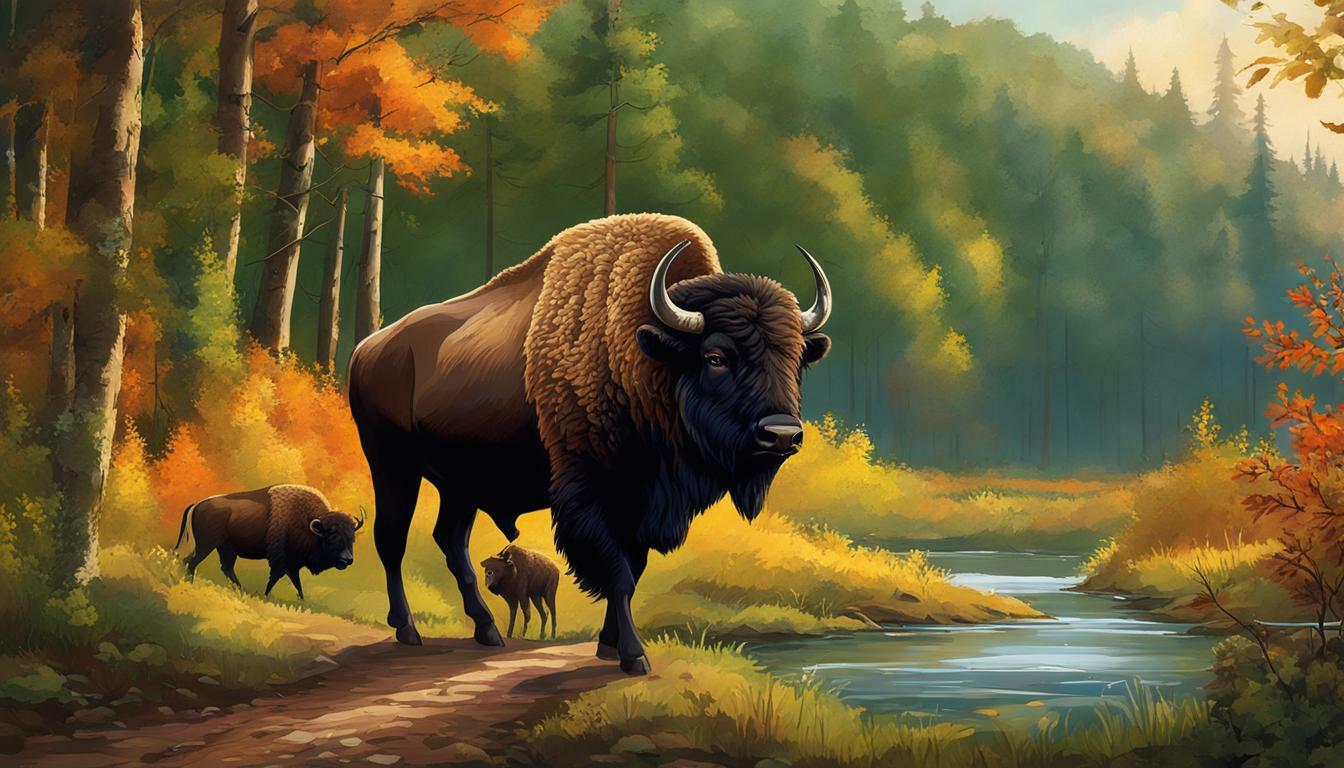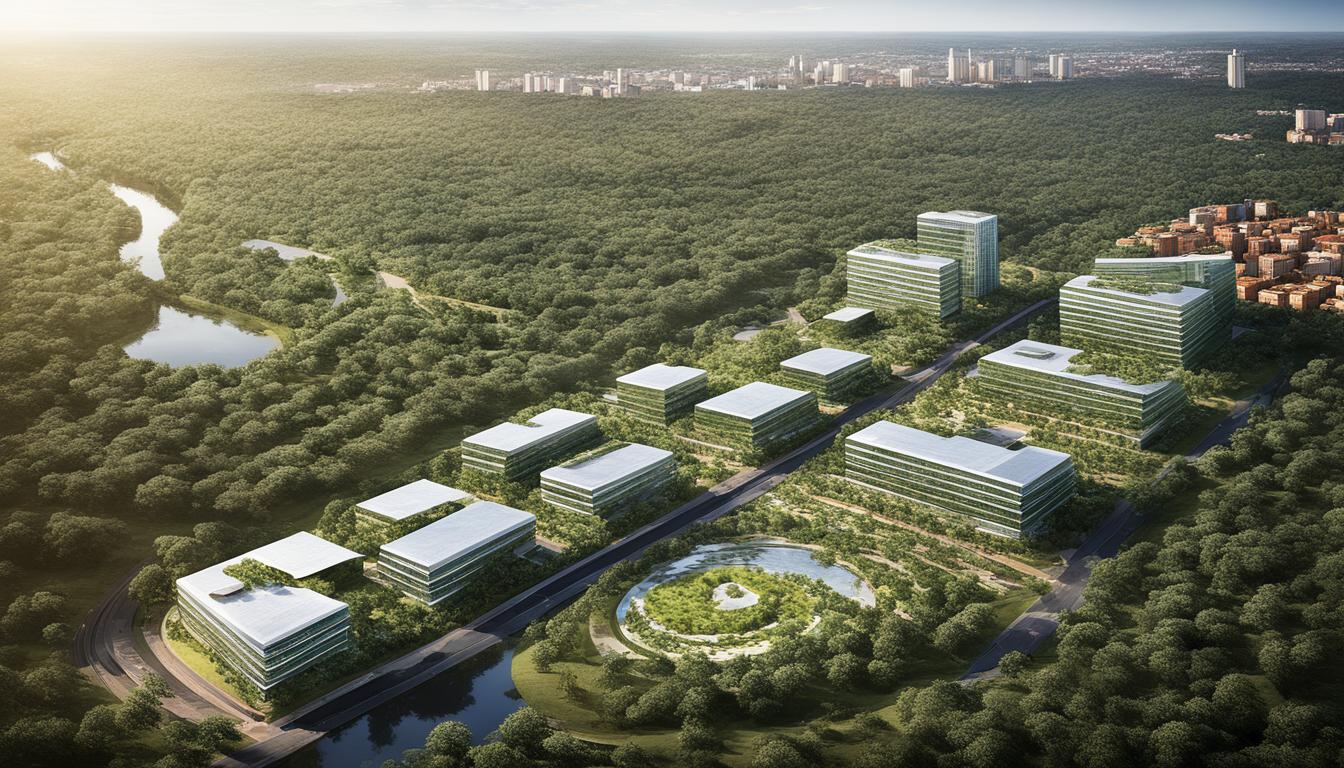Botswana Biodiversity: Animal and Plant Species and What Is Under Threat
Botswana is renowned for its diverse ecosystems and rich biodiversity, which is home to a wide array of unique animal and plant species. The country boasts the magnificent Okavango Delta, a UNESCO World Heritage Site that supports a remarkable variety of flora and fauna. Additionally, Botswana is comprised of seven distinct eco-regions, including two that are classified as Global 200 eco-regions of conservation priority.
The biodiversity in Botswana is truly impressive, with a range of plant and animal species that contribute to the country’s ecological significance. Some of these species are endemic to Botswana, meaning they are found nowhere else in the world. Unfortunately, this biodiversity faces several threats that require urgent attention.
- Botswana is home to diverse ecosystems and rich biodiversity, including the iconic Okavango Delta.
- The country has seven distinct eco-regions, two of which are classified as Global 200 eco-regions of conservation priority.
- Botswana hosts a variety of unique plant and animal species, some of which are endemic to the country.
- Threats to Botswana’s biodiversity include habitat reduction and destruction, barriers to species movement, climate change, poaching, and unregulated tourism.
- The National Biodiversity Strategy Action Plan and comprehensive environmental legislation play a crucial role in conservation efforts.
Exploring the Flora and Fauna of Botswana
The flora and fauna of Botswana offer a fascinating glimpse into the country’s immense biodiversity, with a wide range of plant and animal species residing within its borders. From the vast grasslands of the Kalahari Desert to the lush wetlands of the Okavango Delta, Botswana’s ecosystems are home to numerous unique and endemic species.
Botswana’s flora is characterized by its adaptability to the arid climate, with resilient plants such as the camel thorn tree and the mopane tree dominating the landscape. These trees provide sustenance and shelter to a diverse range of wildlife, including elephants, giraffes, and various bird species.
The country’s fauna is equally diverse, with iconic African animals such as lions, leopards, cheetahs, and zebras roaming freely in protected areas such as Chobe National Park and Moremi Game Reserve. Birdwatchers will be delighted by the abundance of bird species, including the majestic African fish eagle and the vibrant lilac-breasted roller.

| Species | Conservation Status |
|---|---|
| African Elephant | Vulnerable |
| African Wild Dog | Endangered |
| Black Rhino | Critically Endangered |
It is important to note that despite the rich biodiversity of Botswana, many species are under threat. The African elephant, African wild dog, and black rhino are just a few examples of endangered animal species in the country. Conservation efforts and initiatives such as anti-poaching campaigns and community-based conservancies play a crucial role in protecting these vulnerable species.
The exploration of Botswana’s flora and fauna is a constant reminder of the importance of preserving and conserving the country’s biodiversity. By safeguarding these natural treasures, we not only protect the incredible wildlife and habitats but also ensure the sustainability and balance of our planet.
Wildlife Conservation and Protected Areas in Botswana
Botswana places a high emphasis on wildlife conservation, with numerous protected areas established to safeguard the diverse species that call this land home. This commitment to preserving the country’s biodiversity is evident in the establishment of national parks, game reserves, and wildlife management areas spread across its seven eco-regions.
One of the most notable protected areas in Botswana is the Okavango Delta, a UNESCO World Heritage Site and a vital habitat for a wide array of animal and plant species. This unique wetland ecosystem supports a rich diversity of wildlife, including elephants, lions, leopards, giraffes, and over 400 species of birds.
Another significant protected area is the Chobe National Park, renowned for its large herds of elephants and buffalo. It also offers refuge to over 450 bird species and is home to Africa’s largest concentration of African elephants. Along with these flagship reserves, Botswana has established many other protected areas, including the Central Kalahari Game Reserve, Nxai Pan National Park, and Makgadikgadi Pans National Park, ensuring the conservation of its diverse flora and fauna.

In addition to these protected areas, Botswana has implemented various conservation initiatives to mitigate the threats facing its wildlife. Efforts are being made to combat poaching and illegal wildlife trade, with the government employing anti-poaching units and collaborating with international organizations to enhance law enforcement. Community-based natural resource management programs have also been established, involving local communities in conservation efforts and promoting sustainable wildlife management.
By prioritizing wildlife conservation and the establishment of protected areas, Botswana is taking significant steps to safeguard its remarkable biodiversity. However, ongoing challenges such as habitat destruction, poaching, and climate change require constant vigilance and collaborative efforts to ensure the long-term survival of Botswana’s diverse species.
Biodiversity Hotspots in Botswana
Botswana boasts several biodiversity hotspots, areas of exceptional ecological diversity that are of great importance for conservation efforts. These hotspots are characterized by unique ecosystems and a high concentration of endemic species. One such hotspot is the Okavango Delta, a UNESCO World Heritage Site and a haven for a rich variety of flora and fauna.
The Okavango Delta is a vast inland delta formed by the Okavango River, which flows into Botswana from the Angolan highlands. The delta supports a diverse range of habitats, including lush wetlands, savannahs, and woodlands. It is home to iconic African wildlife such as elephants, lions, hippos, and a myriad of bird species. The delta’s intricate network of waterways and islands provides essential resources and refuge for numerous plant and animal species.
Another significant biodiversity hotspot in Botswana is the Central Kalahari Game Reserve. This vast expanse of arid savannah and sand dunes is home to unique species adapted to the harsh desert conditions. It is an important habitat for the endangered African wild dog, as well as various antelope species and migratory birds. The Central Kalahari Game Reserve is a protected area that plays a crucial role in preserving the region’s biodiversity.

These biodiversity hotspots not only harbor a remarkable diversity of plant and animal life but also support crucial ecological processes such as nutrient cycling and water filtration. They contribute to the overall resilience and stability of Botswana’s ecosystems.
| Biodiversity Hotspot | Key Features |
|---|---|
| Okavango Delta | UNESCO World Heritage Site; diverse wetland, savannah, and woodland ecosystems; home to iconic African wildlife |
| Central Kalahari Game Reserve | Large arid savannah; habitat for unique desert-adapted species; plays a vital role in biodiversity conservation |
The protection and preservation of these biodiversity hotspots are of paramount importance. They serve as refuges for endangered species, contribute to the country’s tourism industry, and provide valuable scientific and educational opportunities. Efforts to conserve these hotspots involve the establishment of protected areas, sustainable tourism practices, and community engagement in conservation initiatives.
Threats to Botswana’s Biodiversity
Despite its remarkable biodiversity, Botswana’s flora and fauna are under constant threat from a range of factors, endangering numerous species and necessitating conservation efforts. Habitat reduction and destruction are major concerns, with human activities such as agriculture, urbanization, and mining encroaching on natural habitats. These activities disrupt ecosystems and displace many species, making it difficult for them to survive and thrive.
Another significant threat to Botswana’s biodiversity is climate change. Rising temperatures, changing rainfall patterns, and extreme weather events pose challenges to both plant and animal species. Rapid shifts in environmental conditions can lead to habitat loss, altered migration patterns, and increased vulnerability to diseases, ultimately impacting the survival of various species.
Poaching also remains a critical issue in Botswana, particularly for iconic species such as elephants and rhinos. The illegal wildlife trade continues to fuel the demand for their body parts, threatening their populations and disrupting the delicate balance of the ecosystem. Unregulated tourism, while an important source of revenue, can also contribute to the degradation of habitats and disrupt the behavior patterns of wildlife.
Threats to Botswana’s Biodiversity in Numbers
Here are some key statistics that highlight the extent of the challenges faced by Botswana’s biodiversity:
| Threat | Impact |
|---|---|
| Loss of habitat | Over 50% of Botswana’s land has been affected by human activities, leading to habitat destruction and fragmentation. |
| Poaching | Since 2014, more than 350 elephants have been poached in Botswana, threatening the largest elephant population in Africa. |
| Climate change | Botswana has experienced an increase in temperature of 1.1°C since the 1960s, impacting the distribution and behavior of many plant and animal species. |
| Unregulated tourism | There has been a significant increase in tourism activities in Botswana, with visitor numbers reaching over 1.5 million per year. Without proper management, this can lead to habitat disturbance and stress on wildlife. |
These numbers highlight the urgent need for increased conservation efforts and sustainable practices in Botswana. It is crucial to address these threats and work towards a harmonious coexistence between human activities and the preservation of biodiversity.

“The biodiversity of Botswana is a precious asset that needs to be protected for future generations. It is our collective responsibility to ensure the survival of these unique ecosystems and the species that call them home.” – Dr. Jane Molefi, Conservation Biologist
National Biodiversity Strategy Action Plan
Botswana has implemented a comprehensive National Biodiversity Strategy Action Plan to guide its conservation efforts and promote sustainable development. The plan, developed in accordance with international frameworks such as the Convention on Biological Diversity, sets out strategic goals and actions to protect and manage the country’s biodiversity.
The National Biodiversity Strategy Action Plan aims to tackle key challenges and ensure the long-term conservation of Botswana’s unique ecosystems. It focuses on strengthening protected areas, enhancing sustainable land management practices, promoting community involvement in conservation, and addressing the impacts of climate change.
As part of the plan, Botswana has designated a network of protected areas covering approximately 25% of its land area. These protected areas serve as crucial habitats for a wide range of plant and animal species, including endangered species such as the black rhinoceros and African wild dog. They also provide opportunities for eco-tourism, contributing to the country’s sustainable development goals.
Through the implementation of the National Biodiversity Strategy Action Plan, Botswana is working towards achieving the 2020 Aichi Biodiversity Targets, which include halving the rate of habitat loss, preventing the extinction of endangered species, and ensuring the sustainable use of natural resources. The plan reflects Botswana’s commitment to conservation and underscores the importance of balancing environmental protection with socio-economic development.
| Key Objectives of the National Biodiversity Strategy Action Plan | Actions |
|---|---|
| 1. Strengthen protected areas | Expand and manage protected areas effectively, implement conservation programs for endangered species |
| 2. Promote sustainable land management | Encourage sustainable agricultural practices, combat desertification, and promote reforestation |
| 3. Enhance community involvement | Engage local communities in conservation activities, empower them through sustainable livelihood projects |
| 4. Address climate change impacts | Implement climate change adaptation measures, promote renewable energy, and reduce greenhouse gas emissions |

Botswana’s National Biodiversity Strategy Action Plan signifies the country’s commitment to preserving its rich biodiversity and ensuring sustainable development. By taking a comprehensive approach and involving various stakeholders, Botswana aims to safeguard its natural heritage for future generations. Continued efforts and collaboration will be vital in the face of ongoing challenges and emerging threats.
Environmental Legislation and Funding
Botswana has stringent environmental legislation in place, supported by funding opportunities that aim to protect and preserve the country’s natural environment. The government has recognized the importance of biodiversity conservation and has implemented various laws and regulations to ensure the sustainable management of its ecosystems.
One of the key pieces of legislation is the Wildlife Conservation and National Parks Act, which provides the legal framework for the protection of wildlife and the establishment of national parks and game reserves. This act prohibits activities such as poaching, hunting, and the destruction of habitats, ensuring the safety and preservation of Botswana’s diverse flora and fauna.
In addition to legislation, the government has also established funding mechanisms to support environmental initiatives. The Environmental Fund provides financial assistance to projects aimed at biodiversity conservation, habitat restoration, and sustainable development. This fund plays a crucial role in enabling individuals and organizations to implement environmentally friendly practices and contribute to the preservation of Botswana’s unique ecosystems.
Table: Key Environmental Legislation in Botswana
| Legislation | Description |
|---|---|
| Wildlife Conservation and National Parks Act | Provides legal protection for wildlife and establishes national parks and game reserves |
| National Conservation Strategy | Sets out a comprehensive framework for sustainable development and biodiversity conservation |
| Water Act | Regulates the use and management of water resources to ensure their sustainability |
| Environmental Impact Assessment Act | Mandates the assessment of potential environmental impacts before undertaking development projects |
Botswana’s commitment to environmental conservation is further demonstrated by its participation in international agreements and initiatives. The country is a signatory to the Convention on Biological Diversity and has implemented the National Biodiversity Strategy Action Plan, which focuses on achieving sustainable development while preserving biodiversity.
Overall, Botswana’s stringent environmental legislation, supported by funding opportunities, plays a crucial role in protecting and preserving the country’s natural environment. However, ongoing challenges such as water abstraction, the use of artificial fertilizers, and persistent poaching require continuous efforts and innovative approaches to ensure the long-term sustainability of Botswana’s biodiversity.
Challenges to Biodiversity Conservation
Despite the conservation efforts, Botswana continues to grapple with challenges that threaten its biodiversity, such as water abstraction, artificial fertilizers, and the persistent issue of poaching.
Water Abstraction
Water abstraction, the removal of water from rivers and other natural sources for human use, poses a significant threat to the delicate balance of Botswana’s ecosystems. As water is diverted and consumed for agriculture, industry, and domestic purposes, it disrupts the natural flow and availability of water for wildlife and plant species. The resulting scarcity of water can lead to the drying up of wetlands, impacting the habitats of numerous species.
Artificial Fertilizers
The use of artificial fertilizers in agriculture contributes to the degradation of Botswana’s biodiversity. These fertilizers, containing nitrogen, phosphorus, and other chemicals, are often washed off fields during rainfall or irrigation, ultimately finding their way into rivers and freshwater ecosystems. The excessive nutrient levels lead to algal blooms and eutrophication, which deplete oxygen levels in the water, threatening the survival of aquatic life. Additionally, the runoff from fertilizers can contaminate groundwater, further compromising the health of ecosystems.
Poaching
Poaching remains a persistent issue in Botswana, endangering numerous species and disrupting the delicate balance of the ecosystem. Elephants, rhinos, and other iconic wildlife are targeted for their tusks, horns, and other body parts, driven by the illegal wildlife trade. The killing of these keystone species can have cascading effects on the entire ecosystem, adversely impacting plant-pollinator interactions, seed dispersal, and population dynamics. Despite the efforts of law enforcement agencies and conservation organizations, poaching continues to pose a significant threat to Botswana’s biodiversity.

| Challenges | Impact on Biodiversity |
|---|---|
| Water abstraction | Drying up of wetlands, habitat reduction for aquatic species |
| Artificial fertilizers | Eutrophication, depletion of oxygen levels in water, contamination of groundwater |
| Poaching | Endangerment of iconic wildlife, disruption of plant-pollinator interactions |
In order to protect Botswana’s unique and diverse wildlife, efforts must be made to address these challenges. Sustainable water management practices and stricter regulation of water abstraction can help maintain the ecological balance of rivers and wetlands. Encouraging the use of organic fertilizers and implementing best agricultural practices can minimize the negative impact on soil and water quality. Furthermore, stringent law enforcement and community engagement are essential in combatting poaching and raising awareness about its detrimental consequences.
By addressing these challenges and promoting a harmonious relationship between humans and nature, Botswana can secure a sustainable future for its remarkable biodiversity.
“Conservation is a race against time. We must act now to safeguard the precious biodiversity of Botswana for future generations.” – Dr. Jane Goodall
Threats from Desertification and Encroachment
The arid conditions and desertification in some parts of Botswana, coupled with the encroachment of human habitation into natural habitats, pose significant threats to the country’s biodiversity. As desertification continues to spread, it leads to the degradation of land, loss of vegetation, and the displacement of wildlife. The expansion of human settlements into these fragile ecosystems further exacerbates the situation, putting additional pressure on the already vulnerable species.
Desertification is a process where fertile land gradually transforms into desert-like conditions, primarily due to the misuse of land resources, climate change, and unsustainable agricultural practices. This process has serious implications for both flora and fauna. The loss of vegetation disrupts the delicate balance of ecosystems, making it difficult for native species to survive.
The encroachment of human habitation into natural habitats also has a detrimental impact on biodiversity. As human populations grow, the demand for resources increases, leading to deforestation, habitat destruction, and the fragmentation of ecosystems. The loss of habitat and the disruption of migration routes can have severe consequences for wildlife, pushing species to the brink of extinction.

It is crucial to address the threats posed by desertification and encroachment to safeguard Botswana’s biodiversity. Conservation efforts must include measures to combat desertification, such as sustainable land management practices, reforestation initiatives, and the protection of vital water sources. Additionally, sustainable urban planning and the establishment of protected areas can help mitigate the negative impacts of human encroachment on natural habitats.
By prioritizing the preservation of natural ecosystems and implementing proactive measures, Botswana can work towards maintaining its rich biodiversity and ensuring a sustainable future for both its people and its unique wildlife.
References:
- “Desertification Threatens Biodiversity and Local Livelihoods in Botswana.” World Wildlife Fund, https://www.worldwildlife.org/stories/desertification-threatens-biodiversity-and-local-livelihoods-in-botswana.
- “Desertification and Land Degradation.” United Nations Convention to Combat Desertification, https://www.unccd.int/actions/desertification-and-land-degradation.
- “Encroaching Into Protected Areas: Causes, Impacts, and Solutions.” International Union for Conservation of Nature, 2019, https://www.iucn.org/sites/dev/files/encroachment_2019.pdf.
| Threats | Impact |
|---|---|
| Desertification | Land degradation, loss of vegetation, displacement of wildlife |
| Human Encroachment | Habitat destruction, deforestation, fragmentation of ecosystems |
| Sustainable Solutions | Sustainable land management, reforestation, protected areas, sustainable urban planning |
Conclusion
In conclusion, Botswana’s incredible biodiversity and the conservation efforts put forward are vital to maintain the delicate balance between human development and the preservation of nature’s wonders. Botswana is a country with diverse ecosystems, boasting the UNESCO World Heritage Site, the Okavango Delta, and seven distinct eco-regions. Two of these eco-regions are classified as Global 200 eco-regions of conservation priority, highlighting the country’s commitment to protecting its natural resources.
With a high level of biodiversity, Botswana is home to a wide variety of plant and animal species, including endemic species and those listed on the IUCN Red List. However, this biodiversity is under threat from various factors, such as habitat reduction and destruction, barriers to species movement, invasive species, climate change, poaching, and unregulated tourism.
To address these challenges, Botswana has implemented the National Biodiversity Strategy Action Plan and has taken significant actions towards achieving the 2020 Aichi Biodiversity Targets. The country also has comprehensive environmental legislation and provides funding for environmental initiatives, demonstrating its commitment to conservation.
Despite these efforts, there are still significant challenges to overcome, including water abstraction, the use of artificial fertilizers, and poaching. Additionally, desertification, drought, and the encroachment of human habitation pose threats to wildlife and biodiversity. The recent lifting of hunting bans and wildlife crimes committed by rogue security forces add complexity to conservation efforts.
In order to safeguard Botswana’s rich biodiversity, continued and concerted efforts are needed. By supporting and implementing sustainable practices, raising awareness, and enacting stricter regulations, Botswana can protect its natural treasures for future generations to enjoy.
FAQ
What is the biodiversity like in Botswana?
Botswana has a high biodiversity, with a wide variety of plant and animal species, including endemic species and those listed on the IUCN Red List.
Are there any protected areas in Botswana?
Yes, Botswana has established protected areas to conserve its wildlife and biodiversity. These areas play a crucial role in wildlife conservation efforts.
What are the major threats to biodiversity in Botswana?
The major threats to biodiversity in Botswana include habitat reduction and destruction, barriers to species movement, invasive species, climate change, poaching, and unregulated tourism.
What is the National Biodiversity Strategy Action Plan?
The National Biodiversity Strategy Action Plan is Botswana’s strategic plan to conserve biodiversity and achieve sustainable development. It outlines the country’s goals and actions for biodiversity conservation.
Does Botswana have comprehensive environmental legislation?
Yes, Botswana has comprehensive environmental legislation in place to protect its natural resources and promote sustainable development. This legislation provides a framework for environmental management and conservation.
What are the main challenges to biodiversity conservation in Botswana?
Some of the main challenges to biodiversity conservation in Botswana include water abstraction, the use of artificial fertilizers, and the persistent problem of poaching.
How does desertification and encroachment threaten biodiversity in Botswana?
Desertification, drought, and the encroachment of human habitation into natural habitats pose significant threats to wildlife and biodiversity in Botswana. These factors can lead to habitat loss and fragmentation.
What is being done to protect and support the biodiversity in Botswana?
Botswana has implemented the National Biodiversity Strategy Action Plan and has taken actions to achieve the 2020 Aichi Biodiversity Targets. The country also has funding available for environmental initiatives and has comprehensive environmental legislation in place.
Are there any recent developments or issues regarding biodiversity conservation in Botswana?
The lifting of hunting bans and wildlife crimes committed by rogue security forces have added complexity to conservation efforts in Botswana. Continued efforts are needed to address these issues and protect biodiversity.




